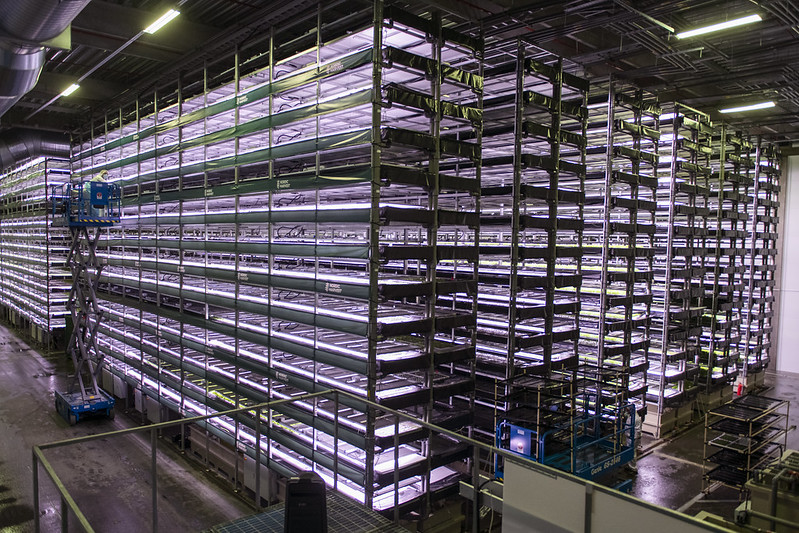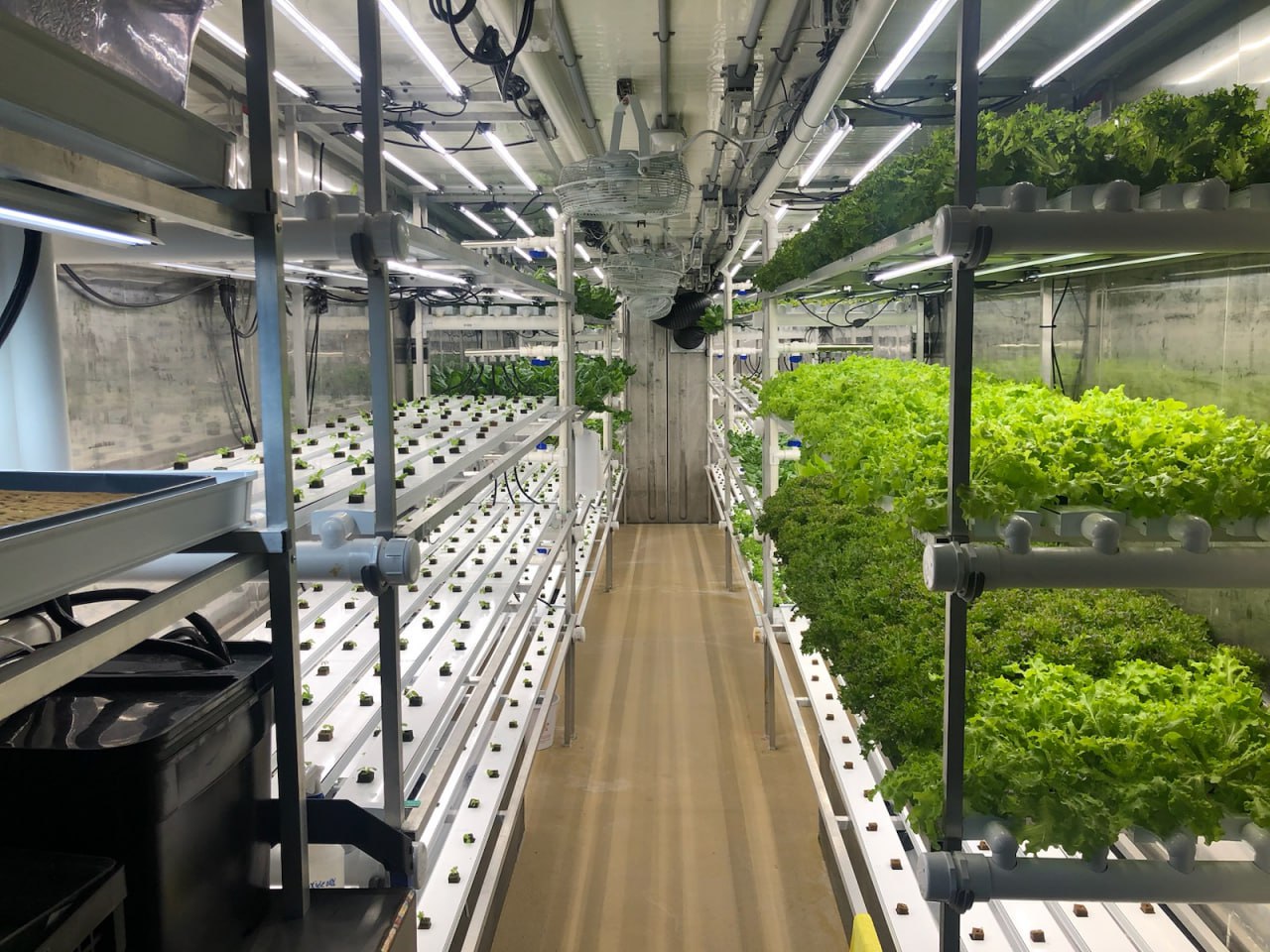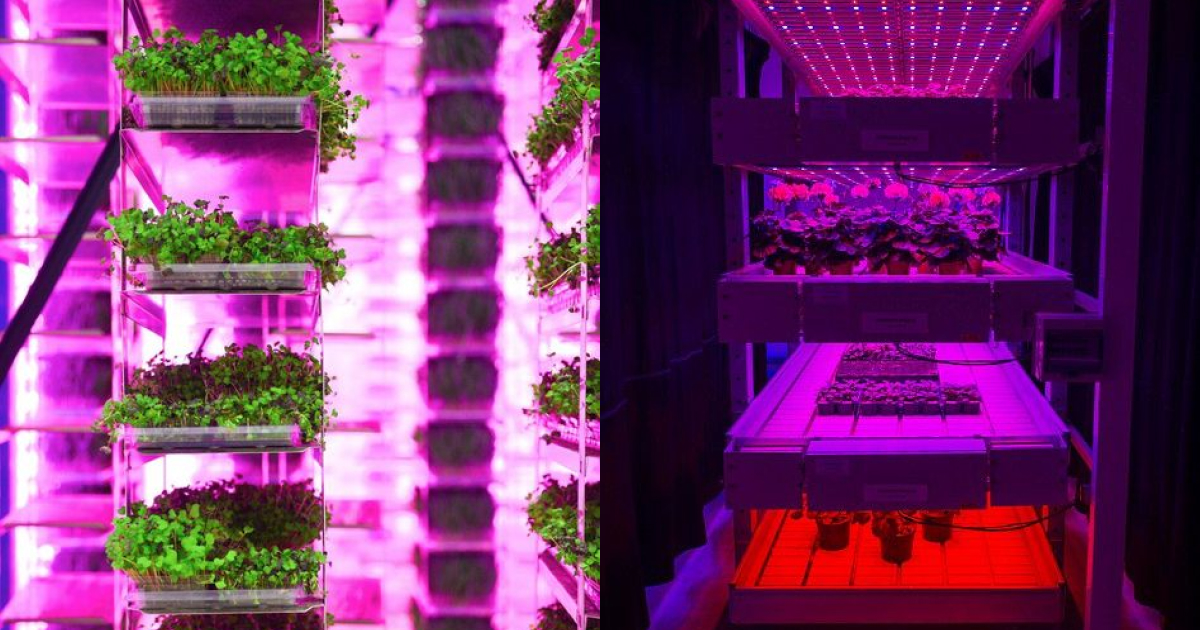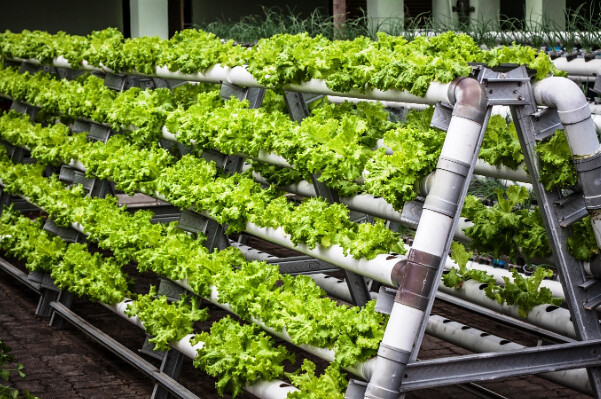
Guide to the Commercial Vertical Farm: Optimizing for Profitability and Peak Yields
A vertical farm facility offers a revolutionary approach to agriculture, giving growers the power to optimize plant growth in a completely controlled environment, independent of external conditions. However, maximizing yields is only half the battle; for a commercial operator, the true goal is achieving profitability. This requires a deep, scientific understanding of three core operational pillars: light, temperature, and nutrients. Mastering these elements is what separates a struggling operation from a successful one, as failure to optimize them leads directly to the high operational costs that have challenged the industry.
Here, we’ll delve into these crucial aspects, drawing insights from a successful vertical farm operation in Alaska to illustrate how meticulous control translates into commercial viability.

LED Grow Lights in a Vertical Farm: From Energy Cost to Profit Driver
Light is the primary energy source for plants, driving photosynthesis. In a vertical farm, artificial lighting is a necessity, but it’s also one of the largest operational costs. This makes your lighting strategy a critical factor in your business’s financial success.

The operation in Alaska, for example, leverages high-efficiency LED lighting to overcome the lack of natural sunlight. In 2025, the commercial standard is tunable, full-spectrum LEDs that allow operators to go beyond simple illumination and deploy crop-specific “light recipes.”. These precise combinations of light spectrum and intensity can steer crop development to enhance flavor, boost nutritional value, and even extend shelf life, creating a premium product that justifies a higher price point.
Research suggests that strategically adjusting the light spectrum can increase yields by up to 20% compared to using generic broad-spectrum white light.
| Light Spectrum Range (nm) | Color Perception | Impact on Plant Growth |
|---|---|---|
| 400-450 nm | Blue | * Encourages vegetative growth (leaf and stem development) * Plays a role in root development * Can influence plant size and shape |
| 450-500 nm | Blue-Green | * Plays a role in photosynthesis, but less efficiently than other wavelengths |
| 500-600 nm | Green | * Less directly utilized by plants for photosynthesis * May contribute to overall plant health * Can influence some light-sensitive pigments |
| 600-660 nm | Red | * Essential for photosynthesis, driving flower and fruit development * Can promote branching and stem elongation |
| 660-700 nm | Deep Red | * Highly effective in promoting flowering and fruit development * Can influence dormancy and seed germination |
| 700-800 nm | Far-Red | * Can influence plant morphology (shape) and flowering responses |
Temperature: Finding the Sweet Spot for Optimal Growth and Risk Mitigation
Temperature plays a critical role in plant physiology, influencing growth rates and metabolic processes. A vertical farm enables precise temperature control, ensuring a consistent and optimal environment.
In Alaska’s challenging climate, the vertical farm maintains a constant temperature, typically between 65-75°F (18-24°C), using sophisticated climate control systems. This approach does more than foster efficient growth; it’s a crucial risk management strategy. An improperly controlled environment can become a breeding ground for fungal diseases that can spread rapidly and lead to catastrophic, costly crop loss. Advanced facilities now use integrated HVAC and positive pressure systems to ensure uniform airflow, which strengthens plants and further minimizes disease risk.
Precision Nutrition: Delivering the Essential Elements in a Vertical Farm
Plants require specific nutrients for healthy development and peak yield. A vertical farm bypasses soil, using soilless techniques like hydroponics or aeroponics to deliver a precisely formulated nutrient solution directly to the plant roots. This maximizes uptake and virtually eliminates nutrient and water waste.
The Alaskan vertical farm, for example, employs a hydroponic NFT system. This method delivers a nutrient-rich water solution directly to the plant’s roots, ensuring they receive exactly what they need at each growth stage. This precision is a key advantage, as hydroponics can reduce water usage by up to 90% compared to traditional soil-based farming, promoting both sustainability and cost savings.
Pros of NFT in a Vertical Farm:
-
Efficient Nutrient Delivery: NFT delivers a precise nutrient solution directly to the plant’s roots, minimizing waste and ensuring optimal uptake at each growth stage. This can lead to faster growth rates and higher yields compared to traditional soil-based methods.
-
Water Conservation: NFT systems are closed-loop, meaning the nutrient solution is continuously recirculated and reused. This drastically reduces water consumption by up to 90% compared to soil-based farming, making it a sustainable water management strategy for vertical farms, especially in arid regions.
-
Space Optimization: NFT systems utilize channels or troughs to hold the nutrient solution, maximizing vertical space within a farm. This efficient use of space is ideal for vertical farming setups with limited square footage.
-
Automation Potential: hydroponic systems are well-suited for automation, allowing for precise control of nutrient delivery and monitoring. This can streamline operations and reduce labor costs for vertical farms.
Cons of NFT in Vertical Farm:
-
Initial Investment: Setting up an NFT system requires an initial investment in channels, pumps, and other infrastructure. This can be a barrier for new or small-scale vertical farming operations.
-
Clogging Risks: NFT systems are susceptible to clogging from plant debris or mineral buildup. Regular maintenance is crucial to ensure optimal flow of the nutrient solution.
-
Power Outages: NFT systems rely on continuous electricity to power pumps and maintain water circulation. Power outages can disrupt nutrient delivery and potentially harm crops if not addressed quickly.
-
Limited Buffering Capacity: NFT systems offer less buffering capacity compared to some other hydroponic methods like media-based systems (e.g., rockwool). This means fluctuations in pH or nutrient levels can occur more rapidly, requiring closer monitoring and adjustments.
Overall, NFT is a well-established and proven method for a commercial vertical farm, particularly for leafy greens and herbs. While there are initial investment and maintenance considerations, the efficient use of resources makes NFT an attractive option.
There are a Few More Systems Commonly Used in a Vertical Farm:
-
Deep Water Culture (DWC): Plants are suspended in a continuously aerated nutrient solution. Simple to set up but requires consistent monitoring of oxygen levels.
-
Ebb and Flow (Flood and Drain): A periodic flood and drain cycle delivers nutrients to a media-filled tray where plants are rooted. Offers some buffering capacity compared to NFT.
-
Aeroponics: Plant roots are misted with a nutrient solution in an enclosed environment. Highly efficient but requires precise control of humidity and air circulation.
-
Aquaponics: Combines aquaculture (fish farming) with hydroponics. Nutrient-rich water from fish tanks is used to feed plants, creating a closed-loop system.
-
Fogponics: Similar to aeroponics, but uses a fine mist instead of larger droplets. Well-suited for high-humidity crops.
-
Vertical Drip Irrigation (VDI): A network of emitters delivers precise amounts of nutrient solution directly to the base of each plant. Offers flexibility in system design.

Achieving a Perfect Vertical Farm Environment: Balancing for Profitability
The true power of a vertical farm lies in the harmonious interplay of light, temperature, and nutrients. By meticulously calibrating each element for a specific crop, growers create a perfect environment that unlocks the plant’s full potential for growth and yield.
The Alaskan case study exemplifies this synergy. The growers have meticulously calibrated their LED lights, climate control system, and hydroponic nutrient delivery. This meticulous approach allows them to achieve not only impressive yields but also the consistent quality and predictable growth cycles that are essential for commercial success.
Beyond the Basics: Advanced Techniques for Peak Performance
For a commercial vertical farm, certain “advanced” techniques are no longer optional—they are essential tools for achieving the efficiency needed to be profitable.
- CO2 Enrichment: Supplementing the atmosphere with carbon dioxide is a standard practice for boosting growth. Studies have shown that CO2 levels around 1,000 ppm can increase yields by 10-30%, directly impacting revenue.
- Vertical Farm Automation: Technology plays a vital role in modern operations. Automated systems for irrigation, nutrient delivery, and climate control reduce labor costs, minimize human error, and free up valuable time for growers to focus on strategic planning and crop monitoring.
While foundational crops like leafy greens and herbs are a great starting point, many commercial operations are now diversifying into higher-value crops like strawberries or specialty greens to better justify the operational costs and increase profit margins.
Conclusion
A vertical farm offers a powerful tool for sustainable and productive agriculture. By strategically managing light, temperature, and nutrients, growers can cultivate thriving crops indoors, regardless of external limitations. The key to commercial success lies in meticulous control, leveraging the latest advancements in technology, and a deep understanding of plant physiology. With dedication and a scientific, business-minded approach, vertical farm operators can unlock peak yields and contribute to a more sustainable future of food production.